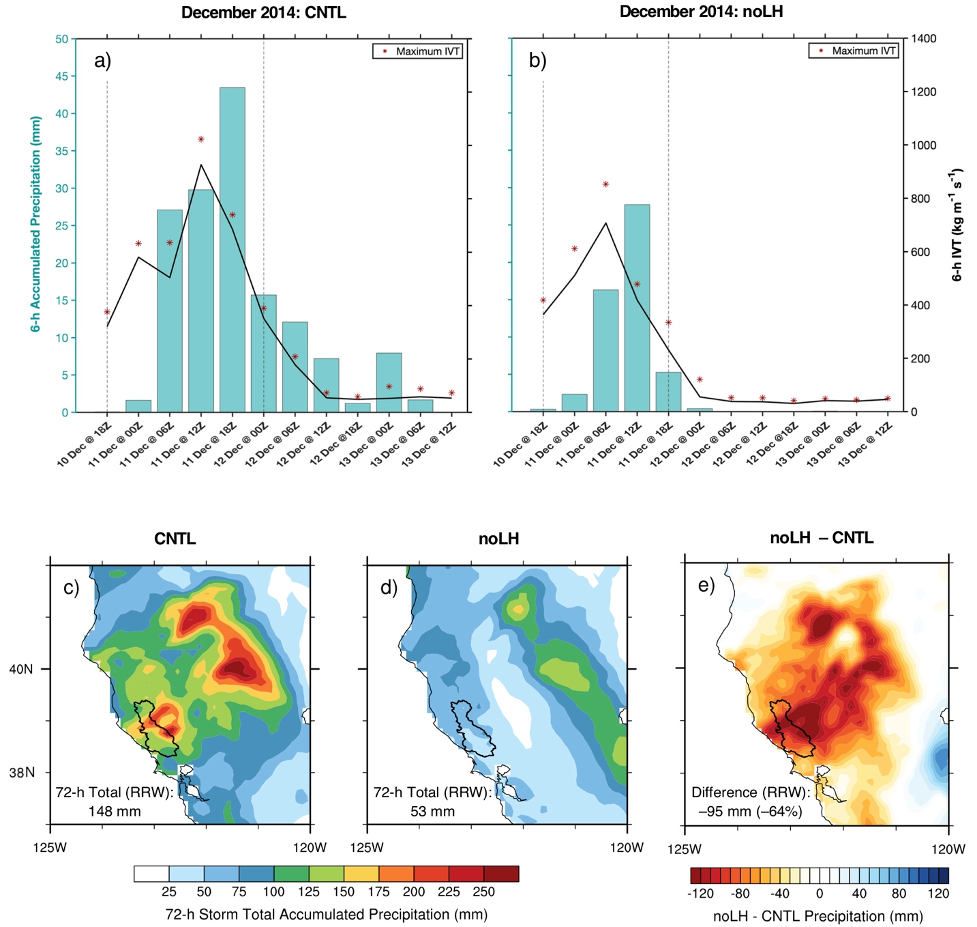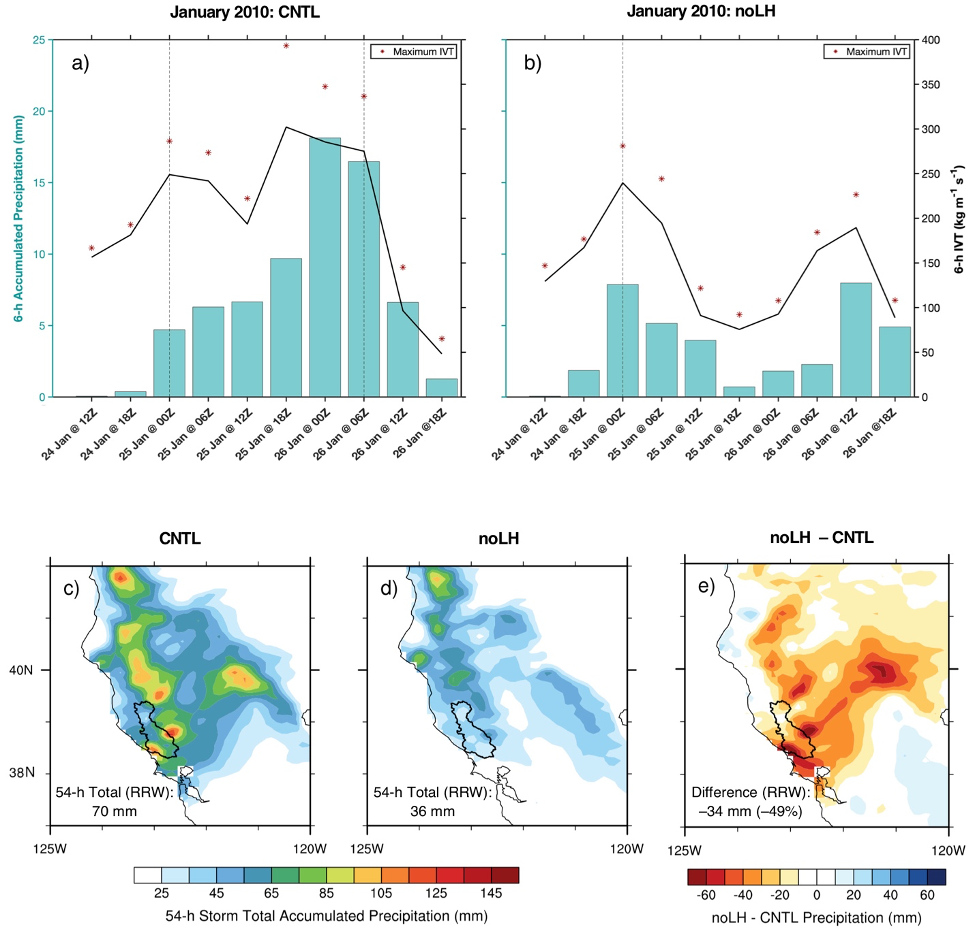CW3E Publication Notice
Modulation of Atmospheric Rivers by Mesoscale Frontal Waves and Latent Heating: Comparison of Two U.S. West Coast Events
July 14, 2021
Allison Michaelis, an Assistant Professor at Northern Illinois University, along with co-authors Andrew Martin (Portland State University), Meredith Fish (Rutgers University), Chad Hecht (CW3E) and F. Martin Ralph (CW3E), recently published a paper titled “Modulation of Atmospheric Rivers by Mesoscale Frontal Waves and Latent Heating: Comparison of Two U.S. West Coast Events” in Monthly Weather Review. This study supports CW3E’s Strategic Plan involving Atmospheric Rivers (AR) Research and Applications by quantifying how diabatic processes contribute to mesoscale frontal wave (MFW) development and AR-MFW interactions.
Michaelis et al. (2021) takes a novel modeling approach by simulating two AR events with associated MFWs that impacted Northern California’s Russian River watershed using the Model for Prediction Across Scales-Atmosphere (MPAS-A) with and without the effects of latent heating. Despite the storms’ contrasting characteristics, diabatic processes within the system were critical to the development of MFWs, the timing and magnitude of integrated vapor transport (IVT), and precipitation impacts over the Russian River watershed in both cases. Low-altitude circulations and lower-tropospheric moisture content in and around the MFWs were considerably reduced without latent heating, contributing to a decrease in moisture transport, moisture convergence, and IVT. Differences in IVT were not consistently dynamic (i.e., wind-driven) or thermodynamic (i.e., moisture-driven), but instead varied by case and by time throughout each event. For one event in mid-December 2014, AR conditions over the watershed persisted for 6 h less and the peak IVT occurred 6 h earlier and was reduced by ~17%; weaker orographic and dynamic precipitation forcings reduced precipitation totals by ~64%. Similarly, turning off latent heating shortened the second event from late-January 2010 by 24 h and reduced precipitation totals by ~49%; the maximum IVT over the watershed was weakened by ~42% and delayed by 18 h.
Removing diabatic processes resulted in clear dynamic and thermodynamic changes which influenced the development of MFWs and their interactions with ARs, underlining the importance of diabatic processes in AR-MFW interactions. Sufficient representation of variables and processes contributing to latent heat release (e.g., water vapor content, vertical motion, microphysical processes, and their subsequent effects and feedbacks), and by extension, accurate initial conditions of the aforementioned variables, is therefore imperative for the accurate representation of MFWs, AR evolution, and precipitation estimates, especially on a watershed scale.
Figure 1: (Top row) 6-hourly accumulated mean areal precipitation (mm) ending at the time indicated on the abscissa for the Russian River watershed (blue bars) and 6-hourly mean areal IVT (kg m-1 s-1) for the Russian River watershed at the end of the precipitation accumulation period (black line) for the December 2014 (a) control (CNTL) and (b) no-latent heating (noLH) simulations. Red asterisks represent the maximum IVT (kg m-1 s-1) over the Russian River watershed at each time. (Bottom row) 72-h accumulated precipitation (mm; 12 UTC 10 December – 12 UTC 13 December) for the December 2014 (c) CNTL, (d) noLH, and (e) noLH minus CNTL simulations. The 72-h storm total for the Russian River watershed is indicated in the bottom left of (c) and (d). The no-latent heating minus control absolute and percent differences are indicated in the bottom left of (e). The Russian River watershed (~39ºN, 123ºW) is outlined in black in all panels.
Figure 2: (Top row) 6-hourly accumulated mean areal precipitation (mm) ending at the time indicated on the abscissa for the Russian River watershed (blue bars) and 6-hourly mean areal IVT (kg m-1 s-1) for the Russian River watershed at the end of the precipitation accumulation period (black line) for the January 2010 (a) control (CNTL) and (b) no-latent heating (noLH) simulations. Red asterisks represent the maximum IVT (kg m-1 s-1) over the Russian River watershed at each time. (Bottom row) 54-h accumulated precipitation (mm; 12 UTC 24 January – 18 UTC 26 January) for the January 2010 (c) CNTL, (d) noLH, and (e) noLH minus CNTL simulations. The 54-h storm total for the Russian River watershed is indicated in the bottom left of (c) and (d). The noLH minus CNTL absolute and percent differences are indicated in the bottom left of (e). The Russian River watershed (~39ºN, 123ºW) is outlined in black in all panels.
Michaelis, A. C., Martin, A. C., Fish, M. A., Hecht, C. W., & Ralph, F. M. (2021). Modulation of Atmospheric Rivers by Mesoscale Frontal Waves and Latent Heating: Comparison of Two U.S. West Coast Events, Monthly Weather Review (published online ahead of print 2021), https://doi.org/10.1175/MWR-D-20-0364.1


